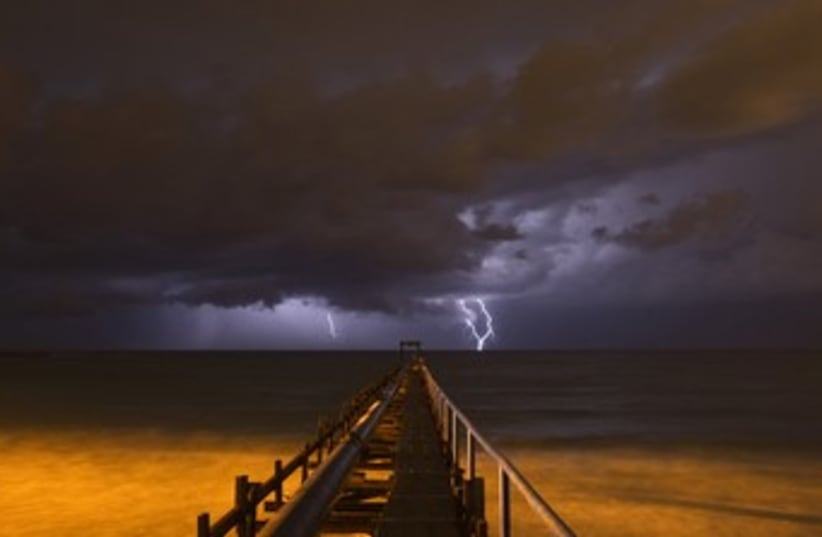Looking back at the way the municipalities in the hilly regions tried to clear the roads and streets during the recent blizzard, Israelis can appreciate the new “digital intelligence system” being tried out in Michigan, Minnesota, and Nevada, as well as Long Island, New York. If it passes key tests, it will be transferred to private vendors and become available to additional states in time for next winter – though due to the comparative rarity of snow in Israel, it would probably be prohibitively expensive here for many years to come.The pilot program uses hundreds of snow plows with custom-designed sensors that continually measure road and weather conditions.Funded by the US Department of Transportation and built by the National Center for Atmospheric Research, the new system is meant to reduce accidents and save state governments millions of dollars in winter maintenance costs.
“This offers the potential to transform winter driving safety,” said NCAR scientist Sheldon Drobot, who oversees the design of the system. “It gives road crews an incredibly detailed, mile-by-mile view of road conditions. They can quickly identify the stretches where dangerous ice and snow are building up.”The new system combines the sensor measurements with satellite and radar observations and computer weather models, giving officials an unprecedented, almost real-time picture of road conditions. With updates every five to 15 minutes, EMDSS will enable transportation officials to swiftly home in on dangerous stretches before deteriorating conditions cause accidents.Motor vehicle accidents involving wintry conditions and other hazardous weather claim the lives of more than 4,000 Americans and injure several hundred thousand per year. To keep roads clear, a single state can spend tens of millions of dollars on maintenance operations over the course of one winter. But transportation officials often lack critical information about road conditions in their own states. They rely on ground-based observing stations that can be spaced far apart. As a result, they have to estimate conditions between weather stations. Snow and ice may build up more quickly along particular stretches of road because of shading, north-facing curves, higher elevation or small-scale differences in weather conditions.If officials dispatch snowplows unnecessarily, or treat roads with sand, salt, or chemicals when not needed, they waste money and harm the environment needlessly.If they do not treat the roads, however, drivers may face treacherous conditions.Using GPS technology, the measurements are coded with location and time. They are transmitted via the Internet or dedicated radio frequencies or cellular networks to an NCAR database, where they are integrated with other local weather data, traffic observations and details about the road’s surface material.TECHNION RESEARCHER ZIPS UP SYNTHESIS Researchers at Haifa’s Technion-Israel Institute of Technology have developed a new “zipper technique” to selectively synthesize complex molecules. The field is central to the development of many new scientific fields, from medicine to materials science.Prof. Ilan Marek of the Technion’s Schulich Faculty of Chemistry has just received a 2.4 million euro grant from the European community for his “different thinking about chemical synthesis and swimming against the current.” He recently described his theories in the prestigious journal Nature.Since the 19th century, the accepted approach to synthesis of organic substances has been the creation of new bonds, especially between carbon molecules, while controlling the spatial structure. This is called three-dimensional or stereo-chemistry, the study of the relative spatial arrangement of atoms that form the structure of molecules and their manipulation.But Marek did not think this was the only way to create complex organic molecules.He and his team for the first time presented a new idea in which they combined simultaneous activation and breaking of carbon- carbon and carbon-nitrogen bonds to obtain in a single stage complex compounds that are very difficult to prepare using conventional means.They used a molecule that at one end involved stress because of the presence of a triangular ring and at the other one a double bond between two carbon atoms. By adding a zirconium compound, they succeeded in causing movement of the double bond, similar to the action of a zipper, to a section containing the triangular ring, which made possible the selective breaking of the tense carbon-carbon bond.“It’s just like zipping up your jacket from the bottom and raising the zipper,” said Marek. “Sometimes the link between the two sides of the zipper disconnects when you move it. We managed to carry out and break in a pre-planned way on the desired carbon-carbon bond.”This achievement is regarded as a breakthrough by materials scientists, and it joins another discovery a year ago by Mark and his team – one also published in Nature – of a new way to make, in just one stage, molecules with a “chiral center,” an atom that is bonded to four different chemical species. Until then, the process had taken several stages. For his development of new synthesis techniques, Marek received the prize of the Israel Chemical Society and the Creativity Prize in Synthesis of the Janssen Pharmaceutica company.New worlds: New technology targets slick winter highways
Motor vehicle accidents involving wintry conditions and other hazardous weather claim the lives of more than 4,000 Americans and injure several hundred thousand per year.
